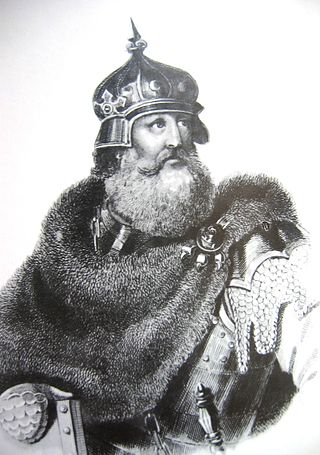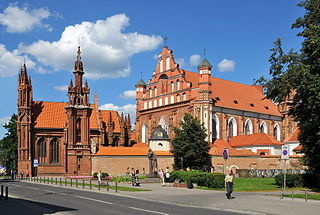
There were many major cities in the Grand Duchy of Lithuania .

There were many major cities in the Grand Duchy of Lithuania .

Trakai is a city and lake resort in Lithuania. It lies 28 kilometres west of Vilnius, the capital of Lithuania or just 7 kilometres from the administrative limits of the Lithuanian capital city. Because of its proximity to Vilnius, Trakai is a popular tourist destination. Trakai is the administrative centre of Trakai district municipality. The city is inhabited by 5,357 people, according to 2007 estimates. A notable feature of Trakai is that the city was built and preserved by people of different nationalities. Historically, communities of Karaims, Tatars, Lithuanians, Russians, Jews and Poles lived here.

The Grand Duchy of Lithuania was a European state that existed from the 13th century to the late 18th century, when the territory was partitioned in 1795 among the Russian Empire, the Kingdom of Prussia, and the Habsburg Empire of Austria. The state was founded by Lithuanians, who were at the time a polytheistic nation born from several united Baltic tribes from Aukštaitija.

Vytautas, also known as Vytautas the Great from the late 14th century onwards, was a ruler of the Grand Duchy of Lithuania. He was also the prince of Grodno (1370–1382), prince of Lutsk (1387–1389), and the postulated king of the Hussites.

Kęstutis was the Grand Duke of Lithuania. He was the Duke of Trakai and governed the Grand Duchy of Lithuania, 1342–1382, together with his brother Algirdas, and with his nephew Jogaila.

Trakai Voivodeship, Trakai Palatinate, or Troki Voivodeship, was a unit of administrative division and local government in the Grand Duchy of Lithuania from 1413 until 1795.

Dzūkija or Dainava is one of five ethnographic regions of Lithuania. Dzūkija is a cultural region defined by traditional lifestyles and dialects of the local Lithuanian population and has never been defined as a political or administrative unit. Traditionally, Alytus is regarded as the capital of the region and largest city. The region has a significant Polish minority of around one third of the region's total population. Although Vilnius is surrounded by Dzūkija, city itself is not included in any ethnographic region.

Skirgaila was a regent of the Grand Duchy of Lithuania for his brother Jogaila from 1386 to 1392. He was the son of Algirdas, Grand Duke of Lithuania, and his second wife Uliana of Tver.

Trakai District Municipality is one of 60 municipalities in Lithuania.

Lake Galvė is a lake in Trakai, Lithuania. It has 21 islands, and one of them houses Trakai Island Castle. Trakai Peninsula Castle is located on its southern shore. There are ruins of the little Orthodox church in Bažnytėlė Island. Trakai was the capital of the Grand Duchy of Lithuania from 1321 to 1323 before moving to Vilnius. The lake and most of the other lakes surrounding the castle and city have myths and legends connected to them, of which most contain a tragic love story.

The Vilnius Voivodeship was one of the Grand Duchy of Lithuania's voivodeships, which existed from the voivodeship's creation in 1413 to the destruction of the Lithuanian state in 1795. This voivodeship was Lithuania's largest, most politically and economically important.
The Lithuanian Council of Lords was the main permanent institution of central government in the Grand Duchy of Lithuania active in its capital city of Vilnius.

Martynas Goštautas was a nobleman from the Grand Duchy of Lithuania of the Goštautai family. He was the Grand Marshal of Lithuania, Voivode of Navahrudak (1464–1471), first Voivode of Kiev (1471–1475) and Voivode of Trakai (1480–1483). He was a servant to King Casimir IV Jagiellon, and was a founder of Tykocin monastery and the Dominican monastery and church in Trakai.

The Duchy of Lithuania was a state-territorial formation of ethnic Lithuanians that existed from the 13th century to 1413. For most of its existence, it was a constituent part and a nucleus of the Grand Duchy of Lithuania. Other alternative names of the territorial formation, used in different periods, were Aukštaitija or Land of Lithuania, Duchy of Vilnius, Lithuania proper, or simply Lithuania.

Marcjan Aleksander Ogiński was a Polish-Lithuanian nobleman, a military commander and a statesman of the Grand Duchy of Lithuania in the Polish–Lithuanian Commonwealth. He advanced to colonel (pulkownik) in 1657, served as Voivod of Trakai and Grand Chancellor of Lithuania. He was the signatory of the Eternal Peace Treaty of 1686 with the Tsardom of Russia, on the side of the Grand Duchy of Lithuania.

Matthias of Trakai or of Vilnius was a Lithuanian Roman Catholic clergyman, the first Bishop of Samogitia from its establishment in 1417 until 1422 and the fifth Bishop of Vilnius from 4 May 1422 until 9 May 1453 and an ex officio member of the Council of Lords.
Knyaz Yurii Chodkiewicz (1515–1569) was a Ruthenian noble, Bielsk starost in 1556, Puńsk starost in 1568, Great Master of the Pantry of Lithuania in 1554, Grand Krajczy of Lithuania in 1555, and Trakai castellan in 1566.

The Lithuanian Civil War of 1381–1384 was the first struggle for power between the cousins Jogaila, Grand Duke of Lithuania and later King of Poland, and Vytautas the Great. It began after Jogaila signed the Treaty of Dovydiškės with the Teutonic Knights which was aimed against his uncle Kęstutis, father of Vytautas. Kęstutis briefly seized power in the Grand Duchy, but was betrayed by adherents of Jogaila primarily from Vilnius. During negotiations for a truce Kęstutis and Vytautas were arrested and transported to the Kreva Castle. Kęstutis died there a week later but Vytautas managed to escape and then sought an alliance with the Teutonic Knights. Subsequently their joint forces raided Lithuanian lands. Eventually the cousins were reconciled as Jogaila needed internal stability in anticipation of negotiations with the Grand Duchy of Moscow and the Kingdom of Poland regarding the possible Christianization of Lithuania. The war did not settle the power struggle; it continued during the next Lithuanian Civil War (1389–1392) which was resolved by the signing of the Ostrów Agreement. After more than ten years of struggle, Vytautas finally became the Grand Duke of Lithuania and ruled the country for thirty-eight years.
Duchy of Trakai was a subdivision of the Grand Duchy of Lithuania during the 14th and early 15th centuries. The Duke of Trakai was an important position held either by the Grand Duke of Lithuania himself or his second-in-command.

Lithuania is not the very centre of Gothic architecture, but it provides a number of examples, partly very different and some quite unique.